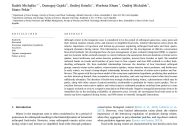Rok
2022Autoři
Domagoj GajskiIng. Ondřej Košulič, Ph.D.
Mgr. Radek Michalko, Ph.D.
prof. Mgr. Stanislav Pekár, Ph.D.
Obsah
Although winter in the temperate zone is considered to be the period of arthropod quiescence, some pests and their natural enemies remain active and interact in simplified food-webs. Limited information exists about the relative importance of top-down and bottom-up processes regulating arthropod food-webs and their spatio-temporal dynamics during winter. This information is essential for the development of effective conservation biocontrol methods. We investigated how the pest management of pear orchards (integrated [IPM] vs organic) and tree location within orchards (margin vs centre) influence the association between densities of winter-active spiders, insect herbivores and winter-inactive predators (spiders, insects) from October to April. We installed carboard bands on trunks and branches of pear trees in four organic and four IPM orchards to collect bark-dwelling arthropods. We then modelled relationships between the densities of four functional arthropod groups, namely winter-active spiders, winter-inactive spiders, winter-inactive insect predators, and herbivores. In early winter, we found a hump-shaped relationship between the densities of winter-active spiders and herbivores. This agrees with the top-down model of the ecosystem exploitation hypothesis, predicting that predators are first bottom-up limited, then accumulate with prey densities, and exert top-down control when they become sufficiently abundant. The densities of herbivores strongly declined during winter, a phenomenon which may be partly, along with other causes of natural mortality, attributable to predation by winter active spiders. The association between winter-active spiders and winter-inactive arthropod predators switched from positive to none in organic orchards or even to a negative association in IPM orchards. Negative intraguild interactions seem to be intensified due to the declining availability of alternative prey. Overall, the investigated food-webs seem to be mostly top-down regulated during winter, and IPM seems to intensify intraguild interactions.



